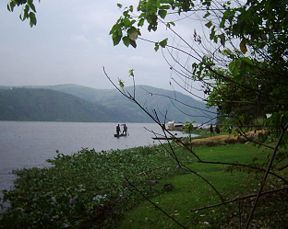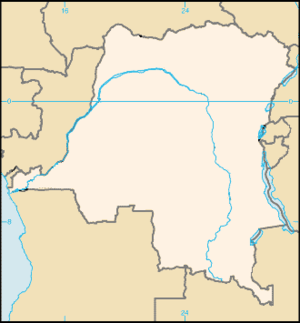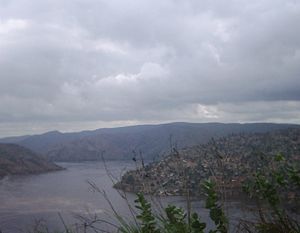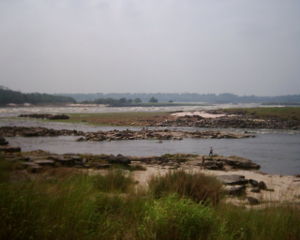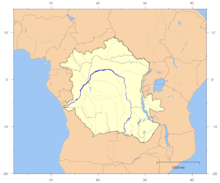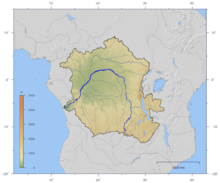Congo River
2008/9 Schools Wikipedia Selection. Related subjects: African Geography
| Congo River | |
|---|---|
| Congo River near Maluku | |
| Mouth | Atlantic Ocean |
| Basin countries | Democratic Republic of the Congo, Central African Republic, Republic of the Congo, Angola, Zambia, Tanzania |
| Length | 4,700 km (2,922 mi) |
| Avg. discharge | 41,800 m³/s (1,476,376 ft³/s) |
| Basin area | 3,680,000 km² (1,420,848 mi²) |
The Congo River (for a time known as Zaire River) is the largest river in Western Central Africa. Its overall length of 4,700 km (2,922 miles) makes it the second longest in Africa (after the Nile). The river and its tributaries flow through the second largest rain forest area in the world, second only to the Amazon Rainforest in South America. The river also has the second-largest flow in the world, behind the Amazon, and the second-largest watershed of any river, again trailing the Amazon; its watershed is slightly larger than that of the Mississippi River. Because large sections of the river basin lie above and below the equator, its flow is stable, as there is always at least one river experiencing a rainy season. The Congo gets its name from the ancient Kingdom of Kongo which inhabited the lands at the mouth of the river. The Democratic Republic of the Congo and the Republic of the Congo, both countries lying along the river's banks, are named after it. Between 1971 and 1997 the government of then- Zaire called it the Zaire River.
The sources of the Congo are in the highlands and mountains of the East African Rift, as well as Lake Tanganyika and Lake Mweru, which feed the Lualaba River, which then becomes the Congo below Boyoma Falls. The Chambeshi River in Zambia is generally taken as the source of the Congo in line with the accepted practice worldwide of using the longest tributary, as with the Nile River.
The Congo flows generally west from Kisangani just below the falls, then gradually bends southwest, passing by Mbandaka, joining with the Ubangi River, and running into the Pool Malebo (Stanley Pool). Kinshasa (formerly Léopoldville) and Brazzaville are on opposite sides of the river at the Pool, where the river narrows and falls through a number of cataracts in deep canyons (collectively known as the Livingstone Falls), running by Matadi and Boma, and into the sea at the small town of Muanda.
The Congo River Basin is one of the distinct physiographic sections of the larger Mid-African province, which in turn is part of the larger African massive physiographic division.
Economic importance
Although the Livingstone Falls prevent access from the sea, nearly the entire Congo is readily navigable in sections, especially between Kinshasa and Kisangani. Railways now bypass the three major falls, and much of the trade of central Africa passes along the river, including copper, palm oil (as kernels), sugar, coffee, and cotton. The river is also potentially valuable for hydroelectric power, and the Inga Dams below Pool Malebo are first to exploit the river.
In February 2005, South Africa's state-owned power company, Eskom, announced a proposal to increase the capacity of the Inga dramatically through improvements and the construction of a new hydroelectric dam. The project would bring the maximum output of the facility to 40 GW, twice that of China's Three Gorges Dam.
Geological history
In the Mesozoic before continental drift opened the South Atlantic Ocean, the Congo was the upper part of a river roughly 12,000 km (7,500 miles) long which flowed west across the parts of Gondwanaland which are now Africa and South America: see Longest rivers.
Tributaries
Sorted in order from the mouth heading upstream.
- Inkisi
- Nzadi
- Nsele (south side of Pool Malebo)
- Bombo
- Kasai (between Fimi and Congo, known as Kwa)
- Fimi
- Lukenie
- Kwango
- Sankuru
- Fimi
- Likouala
- Sangha
- Ubangi
- Giri
- Uele
- Mbomou
- Luvua
- Luapula
Literature
Although not explicitly cited, the Congo River is the location of Joseph Conrad's novel " Heart of Darkness" (published: 1902).
The Congo river is featured in a chapter of Michael Crichton's novel " Congo" (published in 1980), as well as the feature film of the same name, though it is not mentioned by name in the film.
The Congo is also mentioned in Langston Hughes' poem "The Negro Speaks of Rivers"
